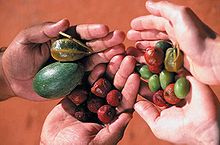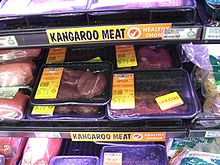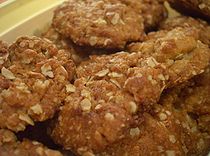- Australian cuisine
-
Arts in Australia Culture of Australia Architecture
Art
Cinema
Comic books
Cuisine
Dance
Literature
Music
Television
Theatre
HumourAustralian cuisine refers to the cuisine of the Commonwealth of Australia and its preceding indigenous and colonial societies. Indigenous Australians have occupied the lands of Australia for some 40,000-60,000 years, during which time they developed a unique hunter gatherer diet, known as "bush tucker", drawn from regional Australian flora and fauna—such as the kangaroo. Seafood is a prominent staple food due to Australia's long coastline. Australia was, from 1788 to 1900, a collection of British colonies in which culinary tastes were strongly influenced by British and Irish traditions - and agricultural products such as beef cattle, sheep and wheat became staples in the national diet. Post-war Australia's multicultural immigration program lead to a diversification of the cuisine of Australia, particularly under the influence of Mediterranean and South East Asian migrants.[1]
Australian cuisine of the first decade of the 21st century shows the influence of globalisation. Organic and biodynamic, kosher and halal foods have become widely available and there has been a revival of interest in bushfoods. British traditions persist to varying degrees in domestic cooking and the takeaway food sector, with roast dinners, the Australian meat pie and fish and chips remaining popular, but there are also new elements featured in these foods. To barbecue meats in the open air is considered a treasured national tradition.
While fast food chains are abundant, Australia's metropolitan centres possess many famed haute cuisine and nouvelle cuisine establishments. Restaurants whose product includes contemporary adaptations, interpretations or fusions of exotic influences are frequently termed "Modern Australian".[2]
Contents
Indigenous Australian bush tucker
Main article: BushfoodBefore the arrival of the First Fleet of Europeans at Sydney in 1788, indigenous Australians survived off the often unique native flora and fauna of the Australian bush, for between 40,000 and 60,000 years. Hunting of kangaroo, wallaby and emu was common. Other foods widely consumed included bogong moths, witchetty grubs, lizards and snakes. Bush berries, fruits, and honeys were also used.[1]
Resource availability and dietary makeup varied from region to region - desert dwellers could be constantly on the move to find new foods, while other tribal districts allowed relatively fixed positioning. Fish were caught using technologies such as spears, hooks and traps. Food preparation techniques also varied, however a common cooking technique was for the carcass to be thrown directly on a camp fire to be roasted.
Development of modern Australian cuisine
 Chinatown, Sydney. Multicultural immigration to Australia has contributed to the development of a diverse cuisine.
Chinatown, Sydney. Multicultural immigration to Australia has contributed to the development of a diverse cuisine.
Following the pre-colonial period, European settlers began arriving with the First Fleet of British ships at Sydney harbour in 1788. The British settlers found some familiar game in Australia - such as swan, goose, pigeon and fish - but the new settlers often had difficulty adjusting to the prospect of native fauna as a staple diet.[1] They set about establishing agricultural industries producing more familiar Western style produce. After initial difficulties, Australian agriculture became a major global producer and supplied an abundance of fresh produce for the local market. Stock grazing (mostly sheep and cattle) are prevalent throughout the continent. Queensland and New South Wales became Australia's main beef cattle producers, while dairy cattle farming is found in the southern states, predominantly in Victoria. Wheat and other grain crops are spread fairly evenly throughout the mainland states. Sugar cane is also a major crop in Queensland and New South Wales. Fruit and vegetables are grown throughout Australia.[3]
 Sheep grazing in rural Australia. Early British settlers introduced Western stock and crops and Australian agriculture now produces an abundance of fresh produce.
Sheep grazing in rural Australia. Early British settlers introduced Western stock and crops and Australian agriculture now produces an abundance of fresh produce.
Other than the indigenous climate and produce, Australian cuisine has been derived from the tastes of immigrant settlers to Australia and the produce they have introduced to the continent. The British colonial period established a strong base of interest in Anglo-Celtic style recipes and methods. Subsequent waves of multicultural immigration, with a majority drawn from Asia and the Mediterranean region, and the strong, sophisticated food cultures these ethnic communities have brought with them influenced the development of Australian cuisine. Besides the culinary heritage of the Anglo-Celtic majority, the cuisines of China, Germany, Greece, Italy, Lebanon, Malaysia, Thailand, Vietnam are not only popular, but have also left the greatest impact on Modern Australian cuisine. In recent times there are also substantial influences and culinary trends from American cuisine, French cuisine, Indian cuisine, Japanese cuisine, Moroccan cuisine and Spanish cuisine.
Fresh produce is readily available and thus used extensively, and the trend (urged by long-term government health initiatives) is towards low-salt, low-fat healthy cookery incorporating lean meat and lightly cooked, colourful, steamed or stir-fried vegetables. With most of the Australian population residing in coastal areas, fish and seafood is popular. In the temperate regions of Australia vegetables are traditionally eaten seasonally, especially in regional areas, although in urban areas there is large scale importation of fresh produce sourced from around the world by supermarkets and wholesalers for grocery stores, to meet demands for year-round availability. During Spring: Artichoke, Asparagus, Beanshoots, Beetroot, Broccoli, Cabbage, Cauliflower, Cucumber, Leek, Lettuce, Mushrooms, Peas, Rhubarb, and Spinach. During Summer: Capsicum, Cucumber, Eggplant, Squash, Tomato, Zucchini.
Australia's climate makes barbecues commonplace. Barbecue stalls selling sausages and fried onion on white bread with tomato or barbecue sauce are common in fund raising for schools or community groups. These stalls are called "Sausage Sizzles".
Beverages
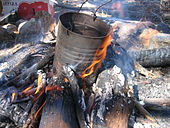 A traditional billycan on a campfire, used to heat water.
A traditional billycan on a campfire, used to heat water.
Billy tea is the drink prepared by the ill-fated Swagman in the popular Australian folksong Waltzing Matilda. Boiling water for tea over a camp fire and adding a gum leaf for flavouring remains an iconic traditional Australian method for preparing tea, which was a staple drink of the Australian colonial period.[1]
 Penfolds Grange, 1999, an Australian wine, made predominantly from the Shiraz (Syrah) grape and usually a small percentage of Cabernet Sauvignon.
Penfolds Grange, 1999, an Australian wine, made predominantly from the Shiraz (Syrah) grape and usually a small percentage of Cabernet Sauvignon.
The Australian Wine Industry is the fourth largest exporter of wine around the world, with 760 million litres a year to a large international export market and contributes $5.5 billion per annum to the nation's economy. There is also a significant domestic market for Australian wines, with Australians consuming nearly 500 million litres of wine per year in the early 21st Century. Wine is produced in every state, with more than 60 designated wine regions totaling approximately 160,000 hectares. Australia’s wine regions are mainly in the southern, cooler parts of the country, in South Australia, New South Wales, Victoria, and Western Australia. Amongst the most famous wine districts are the Hunter Valley and Barossa Valley and among the best known wine producers are Penfolds, Rosemount Estate, Wynns Coonawarra Estate and Lindeman's.[4]
Beer in Australia has been popular since colonial times. James Squires is considered to have founded Australia's first commercial brewery in 1798 and the Cascade Brewery in Hobart, Tasmania, has been operating since the early 19th century. Since the 1970s, Australian beers have become increasingly popular globally - with Fosters lager being an iconic export brand. Fosters is not however the biggest seller on the local market, with alternatives including Victoria Bitter outselling the popular export.
Australia has a distinct coffee culture and is often cited as being one of the most developed and vibrant in the world.[5] The development of the coffee industry has grown not from coffee chains but through independent cafés born out of early Greek and Italian immigration since the early 20th century. The iconic Greek cafés of Sydney and Melbourne were the first to introduce locally roasted coffees in 1910. In 1952, the first espresso machines began to appear in Australia and a plethora of fine Italian coffee houses were emerging in Melbourne and Sydney. Pelligrini’s Espresso Bar and Legend Café often lay claim to being Melbourne’s first ‘real’ espresso bars opening their doors in 1954 and 1956 respectively. This decade also saw the establishment of one of Australia's most iconic coffee brands, Vittoria which remains the country's largest coffee maker and distributor.
 A Cafe Latte with latte art.
A Cafe Latte with latte art.
The Australian invented flat white was developed sometime in the latter half of the 20th century. It has become extremely popular across the country and is one of the most popular espresso beverages. The flat white's popularity has also spread to New Zealand and is beginning to take hold in the United Kingdom. The flat white is a Cafe Latte with no foam.
In the 1980s, Italy’s Lavazza coffee began its export business in Australia, a whole decade before expanding into the UK and US markets. Since this time espresso based coffees have remained the most popular form of coffee amongst Australians [6]
The famous goon sack ( a sack of wine) is mostly drunken by the indigenous and youth's of this generation.
Although Australians often drink tea at home, it has been found that in out-of-home establishments where tea and coffee are sold together, tea accounted for only 2.5% of total sales. To this day, coffee chains such as Starbucks have very little market share in Australia. One reason for this is that unlike in the United States and Asia, Australia already had a developed coffee culture for many decades before their introduction to the market.[7]
Fish and seafood
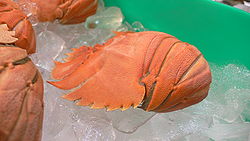 A Balmain Bug, also known as a butterfly fan lobster.
A Balmain Bug, also known as a butterfly fan lobster. Main article: Seafood in Australia
Main article: Seafood in AustraliaAustralia's 11 million square kilometre fishing zone is the third largest in the world and allows for bountiful access to seafood which significantly influences Australian cuisine. Clean ocean environments around Australia produce high quality seafoods for domestic consumption and export. Lobsters, prawn, tuna, salmon and abalone are the main ocean species harvested commercially, while aquaculture produces more than 60 species for consumption including edible oysters, salmonoids, southern bluefin tuna, mussels, prawns, barramundi, yellowtail kingfish, and freshwater finifish .[8] While inland river and lake systems are relatively sparse, they nevertheless provide some unique fresh water game fish and crustacea suitable for dining. Fishing and aquaculture constitute Australia's fifth most valuable agricultural industry after wool, beef, wheat and dairy.[9] Approximately 600 varieties of marine and freshwater seafood species are caught and sold in Australia for both local and overseas consumption.
 Tetsuya's signature dish, Confit of Tasmanian Ocean Trout
Tetsuya's signature dish, Confit of Tasmanian Ocean Trout
Australian cuisine features Australian seafood such as: Southern bluefin tuna, King George whiting, Moreton Bay bug, Mud Crab, Jew Fish, Dhufish (Western Australia) and Yabby. Australia is one of the largest producers of abalone and rock lobster. Fish and chips is a popular take-away food that originated in the United Kingdom and which remains popular in Australia.[10] It generally consists of deep-fried fish (often flake rather than cod in Australia) batter with deep-fried chipped (slab-cut) potatoes. Flathead fish is also popular sport and table fish found in all parts of Australia. Barramundi is an iconic sporting fish found in Northern Australian river systems. Highly prized by anglers for their good fighting ability, it is a common eating dish in seafood restaurants.
Most Australians live close to the coast and have ready access to high quality seafood restaurants and local fish and chip shops. Sydney in particular is noted for its harbourside seafood restaurants, including the Doyles chain in Sydney, notably Doyles on the Beach at Watson's Bay; and Tetsuya's Restaurant owned by chef Tetsuya Wakuda which bases its menu on Australian, Japanese and classic French cuisine, and makes use of Australian ingredients including Tasmanian Ocean Trout.
Fruit
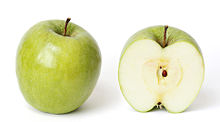 A Granny Smith apple
A Granny Smith apple
There are many species of Australian native fruits, such as Quandong (native peach), Wattleseed, Muntries/Munthari berry, Illawarra plums, Riberry, Native Raspberries and lilli pilli.[11] These usually fall under the category of "bush tucker", (bush foods). Australia also has large fruit growing regions. The Granny Smith variety of apples first originated in Sydney, Australia in 1868.[12]
Regional cuisine
Kangaroo meat at a supermarket
Regional Australian cuisines commonly use locally grown vegetables.[citation needed] In the Southern states of Victoria and South Australia, in particular the Barossa Valley, wines and food reflects the region's traditions and heritage.[13] Barossa's early settlers brought their food traditions with them, instilling the region's cuisine with a strong German, as well as Jobey influence. Preserving, smoking and baking are techniques used in this regional cuisine. The area is famous for its vineyards and the abundance of fresh produce including fruit, nuts, vegetables and citrus. Dishes are made with poultry, livestock, yabbies and hare, some examples are: smoked Mettwurst, Lachsschinken and Bratwurst sausages. Traditional breads and yeasted cakes like Bienenstich and Streuselkuchen, pickled onions and gherkins, olives and olive oil, egg noodles, and a variety of chutneys, pickles and preserves, as well as dried fruits, Barossa cheese and quince paste - are all featured in the cuisine.[14]
Breakfast
 Vegemite on toast.
Vegemite on toast.
The breakfast frequently resembles breakfast in many Western countries, but may include ethnic influences. In warmer areas breakfast is generally light. In colder seasons and regions porridge or a full English breakfast may be consumed. The light breakfast commonly consists of breakfast cereal, toast, fruit. Beverages taken at breakfast include tea, coffee, flavoured milk, or juice. A popular breakfast food in Australia is Vegemite, a spread similar to Marmite.
Dinner
The evening meal is the main meal of the day for most Australians. It is usually consumed at home with members of the immediate family or household. Common choices would be roast meat and vegetables, pasta, pizza, casseroles, barbecued meat, fish and seafood, vegetables, salad, soup, curries and stir-fries.
A standard cafe or restaurant in Australia not adhering to any particular ethnic cuisine might offer sandwiches and focaccias, a range of pasta, risotto, pizza, salad, curry dishes, steak, chicken or other meat-based dishes, schnitzels, fish, cakes or other desserts, red and white wine, soft drink, beer, and coffee.
Iconic Australian foods
An iconic Australian foodstuff is Vegemite (owned by the American Kraft Foods[15]). Other unique or iconic national foods include Macadamia nuts; Violet Crumble, a honeycomb chocolate bar; Cherry Ripe; Jaffas, chocolate with an orange-flavoured confectionery shell; the Chiko Roll, a deep-fried savoury roll similar to a spring roll; and the Dim sim, a Chinese-inspired dumpling. Other popular Australian foods include Tim Tams, a chocolate biscuit; Musk sticks; Fairy bread; Lamingtons; the Boston bun; the Vanilla slice; and the commercial breakfast cereal Weet-Bix. The Australian burger is made with a beef patty, Worcestershire sauce, pickled beets, lettuce and salad items, bacon and a fried egg on top. Pineapple slices and cheese are sometimes but not always used.[16] ANZAC biscuits and the pavlova are considered by some to be Australian national foods,[17][18] although the oldest known named recipe for pavlova is from New Zealand.[19] It has been debated that the current Pavlova is an improvement on the recipe of a meringue cake found in a New Zealand magazine.[20] The meat pie is a well known take away item. Kangaroo meat is readily available in Australia although it is not a commonly eaten meat. It is available in various cuts and sausages.[21]
Damper is a traditional Australian soda bread prepared by swagmen, drovers and other travellers. It consists of a wheat flour based bread, traditionally baked in the coals of a campfire.
ANZAC biscuits, made without coconutA pavlova garnished with strawberries, bananas, kiwifruit and cream.Damper (soda bread) being cooked over hot coals.Australian foods Take-away food in Australia
Typical serving of fish and chips in Williamstown.
Similar to other Western nations, Australia has a wide variety of takeaway food available from other cultures. The meat pie and sausage rolls are take-away food items, and there is also gourmet pies. Found in some takeaway shops is the 'Australian Hamburger'. This is mainly distinguished from other hamburgers by the range of fillings available. An order with all fillings is known as "The Lot" or "The Works". The fillings include lettuce, tomato, cheese, pickled beetroot, fried onion, bacon and a fried egg. American fast food outlets are common, and there are also Australian fast food chains and individual outlets selling pizza, charcoal or fried chicken, kebabs, gyros, and fish and chip shops.
Doner kebab—usually called just kebabs—are very popular owing to immigration from Greece, Turkey, the former Yugoslavia and Lebanon. Shops or vans selling kebabs are colloquially referred to as "Kebaberies" and "Kebabavans" in some parts of Australia. In Melbourne, they are called souvlaki and in the South Australia they are called yiros. Kebab meat can also be found as a pizza topping in the western suburbs of Sydney and Melbourne, as a "beef pizza" or "Turkish pizza". Doner kebabs in Sydney and Melbourne can be served with all the ingredients placed onto or next to the pita bread on a plate, or more commonly, with the ingredients rolled into the pita bread in the form of a "wrap". The "late night kebab" has become an icon of urban food culture in Australia, with kebabs often purchased and consumed following a night of drinking. Kebabs are considered suitable following consumption of alcohol due their high content of lipids (fats) which aids in metabolism of alcohol.
A very wide variety of Chinese, Indian, and various Asian restaurants provide eat-in and take-away services, and are very popular in the cities. With the high levels of immigration from the Middle East, South and South East Asia, Korea, China and other countries from all over the world to Australia, many authentic and high-quality restaurants are run by first and second generation immigrants from these areas. Chinese cuisine ranges from a long established Australian-Chinese style based on the cooking of the Chinese community established during the gold rushes of the late 19th century, to quite different cuisine more recently imported from different regions of China. Asian bakery stores are also a source of fast food such as savoury rolls. Examples of these include cheese and bacon, cheese and pineapple, which are toppings over a thick piece of bread, and the pork/chicken roll (Banh Mi Thit), which is a crusty baguette, cut with sliced pork or chicken, carrot, spring onion, soy sauce, pâté, coriander, cucumber and often chili.
Prominent Australian chefs
Prominent Australian chefs include:
- Cheong Liew
- Maggie Beer
- David Thompson
- Jean-Paul Bruneteau
- George Calombaris
- Guillaume Brahimi
- Peter Russell-Clarke
- Gabriel Gaté
- Peter Gilmore
- Bill Granger
- Stephanie Alexander
- Kylie Kwong
- Luke Nguyen
- Guy Grossi
- Stefano Manfredi
- Gary Mehigan
- Matt Moran
- Mark Olive
- Ben O'Donoghue
- Neil Perry
- Poh Ling Yeow
- Tobie Puttock
- Cindy Sargon
- Curtis Stone
- Tetsuya Wakuda
- Julie Goodwin
See also
Notes
- ^ a b c d "Australian food and drink - australia.gov.au". Cultureandrecreation.gov.au. 2008-09-23. http://www.cultureandrecreation.gov.au/articles/foodanddrink/index.htm. Retrieved 2011-09-17.
- ^ "Modern Australian recipes and Modern Australian food : SBS Food". Sbs.com.au. http://www.sbs.com.au/food/cuisineindex/RecipeByCuisineMain/383. Retrieved 2011-09-17.
- ^ "Australian farms and farming communities - australia.gov.au". Cultureandrecreation.gov.au. 2011-05-10. http://www.cultureandrecreation.gov.au/articles/farms/. Retrieved 2011-09-17.
- ^ "Australia's wine industry - australia.gov.au". Cultureandrecreation.gov.au. 2007-12-14. http://www.cultureandrecreation.gov.au/articles/wine/. Retrieved 2011-09-17.
- ^ "Coffee Academy, Australia, Brisbane, Melbourne, Coffee Art". Barista Basics. 2006-03-28. http://www.baristabasics.com.au/article.asp?AID=49. Retrieved 2011-09-17.
- ^ "Aussie café culture accounts for ‘biggest growth in coffee’ | Australian Food News". Ausfoodnews.com.au. 2010-03-04. http://www.ausfoodnews.com.au/2010/03/04/aussie-cafe-culture-accounts-for-biggest-growth-in-coffee.html. Retrieved 2011-09-17.
- ^ James Braund. "Caffeination: Australia’s (obsessive) coffee culture - travel tips and articles". Lonely Planet. http://www.lonelyplanet.com/australia/travel-tips-and-articles/69143. Retrieved 2011-09-17.
- ^ "About Australia: The Australian seafood industry". Dfat.gov.au. http://dfat.gov.au/facts/seafoodindustry.html. Retrieved 2011-09-17.
- ^ "Fisheries Home". DAFF. 2011-09-13. http://www.daff.gov.au/fisheries. Retrieved 2011-09-17.
- ^ "Food History Timeline", BBC/Open University.
- ^ http://www.cse.csiro.au/research/nativefoods/nativefoods_website.pdf
- ^ "Granny Smith and her Apples". Archived from the original on 2007-08-11. http://web.archive.org/web/20070811001112/http://www.ryde.nsw.gov.au/ryde/msherwood.htm. Retrieved 2007-08-11.
- ^ "South Australian Food and Wine Tourism Strategy 2009 – 2014." South Australian Tourism Industry Council. Accessed July 2011.
- ^ "Barossa Food - South Australia - South Australia. A brilliant blend". South Australia. http://www.southaustralia.com/BarossaFood.aspx. Retrieved 2011-09-17.
- ^ "Home". Vegemite. http://www.vegemite.com.au/vegemite/page?PagecRef=1. Retrieved 2011-09-17.
- ^ "Australian burger recipe". burgers here and there. 2011-03-02. http://burgershereandthere.com/2011/03/02/australian-burger-recipe/. Retrieved 2011-09-17.
- ^ "www.aussie-info.com Pavlova page". Aussie-info.com. http://www.aussie-info.com/identity/food/pavlova.php. Retrieved 2011-09-17.
- ^ www.aussieslang.com "Anzac biscuits"
- ^ Pavlova palaver, by Susette Goldsmith, New Zealand Listener (reviewing The Pavlova Story: A Slice of New Zealand’s Culinary History, By Helen Leach)
- ^ "Hands off our pavlova, Kiwis warned - The West Australian". Au.news.yahoo.com. 2010-12-03. http://au.news.yahoo.com/thewest/a/-/breaking/8448848/hands-off-our-pavlova-kiwis-warned/. Retrieved 2011-09-17.
- ^ "KIAA - Kangaroo Meat Cuts". Kangaroo-industry.asn.au. http://www.kangaroo-industry.asn.au/products/cuts.htm. Retrieved 2011-09-17.
References
- Bruneteau, Jean-Paul, Tukka, Real Australian Food, ISBN 0-207-18966-8
- Cherikoff, Vic, The Bushfood Handbook, ISBN 0-7316-6904-5
- Cherikoff, Vic, Uniquely Australian, ISBN 0-646-07470-9
- Cherikoff, Vic and Christie, Benjamin, The Dining Downunder cookbook. ISBN 0-9752-0210-3
- Dwyer, Andrew, "Outback Recipes and Stories from the Campfire". ISBN 978-0-522-85380-3
- Kersh, Jennice. & Kersh, Raymond. (1998) Edna's Table (Restaurant) Rydalmere, N.S.W. Hodder & Stoughton. ISBN 0-7336-0539-7
External links
- Australian food and drink - Native Australians and early settlers
- Australian Flavour - Recipes verified as having been cooked in Australian in the late 1800s and 1900s plus others considered iconic
- Regency TAFE information website
- Australian Food Worldwide
Oceanic cuisine Sovereign states - Australia
- East Timor (Timor-Leste)
- Fiji
- Indonesia
- Kiribati
- Marshall Islands
- Federated States of Micronesia
- Nauru
- New Zealand
- Palau
- Papua New Guinea
- Samoa
- Solomon Islands
- Tonga
- Tuvalu
- Vanuatu
Dependencies and
other territories- American Samoa
- Christmas Island
- Cocos (Keeling) Islands
- Cook Islands
- Easter Island
- French Polynesia
- Guam
- Hawaii
- New Caledonia
- Niue
- Norfolk Island
- Northern Mariana Islands
- Pitcairn Islands
- Tokelau
- Wallis and Futuna
 Australia topics
Australia topicsHistory Timeline · Prehistory · Archaeology · Exploration · 1606–1787 · 1788–1850 · 1851–1900 · 1901–1945 · Since 1945 · Constitutional · Diplomatic · Economic · Federation · Immigration · Indigenous · Military · Monarchy · RailwayGeography States and Territories · Capitals · Cities · Cities by population · Climate · Continent · Deserts · Environment · Flora · Fauna · Forests · Geology · Islands · Mountains · Regions · Protected Areas · RiversGovernance Government · Constitution · Monarchy · Australian governments · Parliament · Foreign relations · Military · Law · Law Enforcement · Courts · Electoral system · Public Service · Federal Budget · National debtPolitics Economy Agriculture · Companies · Energy · Home ownership · Homelessness · Manufacturing · Media · Mining · Poverty · Taxation · Telecommunications · Tourism · Transportation · Australian dollar · Reserve Bank · Stock Exchange · Household income · Gross state product · Welfare system · SuperannuationSociety Culture Australians · Architecture · Arts · Australian English · Cinema · Cuisine · Wine · Dance · Indigenous · Literature · Music · Public holidays · Religion · Sport · Television · Theatre · ArtSymbols Other topics  Category ·
Category ·  Portal ·
Portal ·  WikiProjectCategories:
WikiProjectCategories:- Australian cuisine
- Cuisine by continent
Wikimedia Foundation. 2010.


